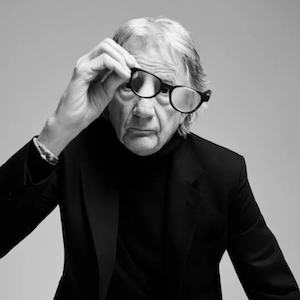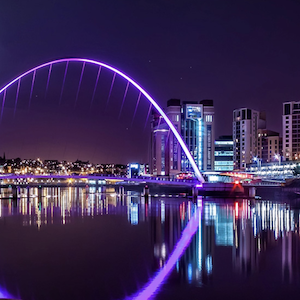Flowing; A View From A Bridge
By Jo Phillips
Building a bridge is simple in concept but complex in design. The 20th and early 21st Century has seen an upheaval of architects showcasing their technical expertise when it comes to aesthetic design of a bridge.
Functionality is of course the main reason for building a bridge, to physically link previous independent areas whilst providing a new means of access. All around the world architects are either creating or completing inspired projects which range in sizes, use diverse materials, and come in a variety of unconventional forms,
Worldwide urbanisation has rapidly increased the requirement for the ease of travel. As part of our June theme Flowing we have decided to look at eight contemporary bridges which have redefined the way in which communities and the public travel and are each individually magnificent in their design.
Cirkelbroen Bridge, Copehagen, Denmark
Danish-Icelandic artist Olafur Eliasson is the mastermind behind the Cirkelbroen Bridge in Copenhagen, Denmark which opened to the public in 2015. The bridge spans the Christianshavn Canal and was designed as a testimony to Copenhagen’s nautical history, with the bridge’s posts taking the form of ship masts which are visible from the surrounding areas.
Inspired by the memory of moored fishing boats from Eliasson’s childhood, the footbridge is made from five interconnected but irregularly sized circular platforms to resemble a collection of boats which you can walk across.
Such a concept allows the public to slow down, shift their focus and observe different perspectives from their surrounding area, transforming the bridge into a unique observation post and landmark by its neighbouring users.
 Photograph of Cirkelbroen Bridge, Copehagen, Denmark
Photograph of Cirkelbroen Bridge, Copehagen, Denmark
© Susanne Nilsson
Image size changed to pixels: 700 width and height 465
Source
Lucky Knot Bridge, Changsha Lake District, China
The innovative combination of Dutch expertise in infrastructure and Chinese knowledge of local contexts results in the Luck Knot Bridge in the Changsha Lake District of China.
Completed in 2016 by NEXT Architects, this pedestrian bridge was a significant development of the local area’s public space. Lucky Knot bridge was designed with recreational, ecological and tourist activities in mind by connecting multiple levels at different heights.
The original design is inspired by the principle of the Möbius ring as well as the traditional art of Chinese knotting, where knots are often used to symbolise luck and prosperity. The Lucky Knot bridge owes its imaginative design to the modern interpretation of tradition and is a perfect example of the fusion between art, tradition, design, and functionality.
 Photograph of Lucky Knot Bridge, Changsha Lake District, China
Photograph of Lucky Knot Bridge, Changsha Lake District, China
© NEXT Architects /Photography: Julien Lanoo
Image size changed to pixels: 700 width and height 461
Red Pyramid Bridges, Reykjavík, Iceland
Identical in shape, the two pedestrian and cycle bridges across the Elliðaár estuary are a prime example of the emphasis on sustainable transport in Iceland.
Completed in 2013 by local architect firm Teiknistofan Tröð, the concept for both bridges were based on the three rules of sustainable development; ecological, social, and economic sustainability. The minimal silhouette of the tetrahedron shape amplifies each bridge’s identity as a structural piece of land art against Iceland’s rural landscape.
 Photograph of Red Pyramid Bridges, Reykjavík, Iceland
Photograph of Red Pyramid Bridges, Reykjavík, Iceland
© Teiknistofan Tröð
Image size changed to pixels: 700 width and height 467
Source
Helix Bridge, Singapore, Asia
Cox Architecture and engineer Arup are behind the intricate design of the world’s first curved double-helix bridge. Inspired by the geometric shape of a DNA, the Helix Bridge evolved from the desire for a delicate and lightweight crossing. The 280-metre-long bridge spans the river between the Singapore’s central business district and the newly established bayfront area, home to the iconic hotel Marina Bay Sands.
To emphasize the interplay between both helix tubes, LED lights illuminate the structure by night and as pedestrians walk along, there are four viewing platforms offer a 360-degree view over the bay – which is bound to ensure breath-taking views and spectacular photos!
 Photograph of The Helix Bridge, Singapore, Asia
Photograph of The Helix Bridge, Singapore, Asia
© Jeffery Wong
Image size changed to pixels: 700 width and height 467
Source
BP Pedestrian Bridge, Chicago, United States
With such constantly demanding lives, we live in a world where people would typically favour the quickest route from A to B. Frank Gehry’s design of the BP bridge however goes against the status-quo to resemble a slithering snake, complete with a scaly exterior. The biomorphic exterior of the bridge was created using over 10,000 steel panels.
Located in downtown Chicago, the BP bridge connects Daley Bicentennial Plaza with the city’s infamous Millennium Park. The curves of the bridge offer pedestrian’s a different viewpoint at every turn, a unique design feature I must say, there are no handrails, as the steel parapets create a ledge that users can hold on to as they cross.
 Photograph of The BP Pedestrian Bridge, Chicago, United States
Photograph of The BP Pedestrian Bridge, Chicago, United States
Original Photography: Torsodog ©
Image size changed to pixels: 700 width and height 372
Source
Python Bridge, Amsterdam, Netherlands
Continuing the snake theme, the Phyton Bridge won the International Footbridge Award in 2002. Located in Amsterdam, the bridge connects Sporenburg and Borneo Island and was designed by Adriaan Geuze of the architectural firm West 8.
The light poles along the side of the bridge mimic the heads of seagulls, a prominent bird amongst the hustle and bustle of central Amsterdam. Obviously unsuitable to be travelled on Amsterdam’s preferred method of transport, bicycles, the Python Bridge is reminiscent of a structure to be found in a school playground.
 Photograph of The Python Bridge, Amsterdam, Netherlands
Photograph of The Python Bridge, Amsterdam, Netherlands
© Fred Bigio
Image size changed to pixels: 700 width and height 481
Source
The Rolling Bridge, London, United Kingdom
The humble Rolling Bridge in London is a remarkable engineering achievement. Although smaller in size that the previous bridges we have discussed, this bridge certainly displays true creativity.
Built as a pedestrian bridge to span an inlet of the Grand Union Canal at Paddington Basin, the bridge also needed to open to allow access for boats moored in the inlet.
The typical approach to building such a bridge is to have a single rigid element that lifts out of the way, but London based practice Heatherwick Studio designed the Rolling Bridge to open and close as from a straight bridge into a circular sculpture which sits on the bank of the canal.
 Photograph of The Rolling Bridge, London, United Kingdom
Photograph of The Rolling Bridge, London, United Kingdom
© Loz Pycock
Image size changed to pixels: 700 width and height 470
Source
Murinsel, Graz, Austria
In 2003, New York artist Vito Acconci, designed an artificial floating platform with two footbridges connecting the platform to both sides of the Mur river in Austria.
The organic form of the platform was design in the shape of a giant sea shell. This structure provides a well thought integration with nature and a connection to the city. The centre of the platform forms an amphitheatre, but an outside terrace provides a space where tourists and residents can lounge in the sun, or on colder days relax in the indoor café.
 Photograph of Murinsel, Graz, Austria
Photograph of Murinsel, Graz, Austria
With the frequent challenge of the perceptions of space and ecological design, these eight bridges have been executed with extraordinary proficiency. A functional yet aesthetically pleasing design is where we observe true innovation, and although some are more minimal than others, we must appreciate how stimulating each of these bridges are to marvel at.





